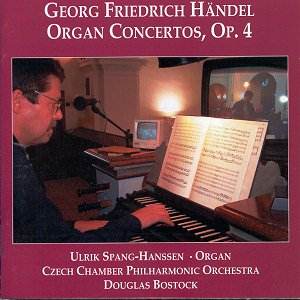Handel’s concertos for organ and orchestra first came
to use as incidental music between the acts of oratorios. The
audiences of Handel’s day must have had either a huge appetite
for music, or not much better to do with their time. Imagine if
you will a performance of a work the length of Messiah,
which if done in toto can last nearly two and a half hours.
Add to that a concerto of between nine and fifteen minutes in
length between each of the three sections and you have a production
of Wagnerian proportions. Nonetheless, these utterly charming
and captivating scores have survived as music in their own right,
and have seen in recent years their fair share of recorded performances.
If one were to categorize this performance by
Ulrick Spang-Hanssen and the Czech Chamber Philharmonic Orchestra,
one would have to conclude that this is the way indeed that things
should be done, and all of the other fussy, whiny period instrument
groups should head up and take note. After several attempts, I
can simply find no flaw with this disc other than there are a
few typos in the booklet, and I had to add up the total time to
include it in this review.
This performance is far from "authentic,"
but then again, the purists get it wrong too by attempting to
play this music with only one to a part in the strings, making
it sound as if it were intended for the drawing room and not the
grand theatre. This modest style may work for Bach, who had limited
resources of which he often complained, but the master theater
maker Handel had no fewer than forty musicians at his disposal.
And if accounts are correct, he needed that many to be heard over
the notoriously unruly crowds in the opera house. If you think
that cell phones are rude, how about blatant raucous cat calling
and unabashed conversations while you are trying to sing an opera?
These performances do not resort to bringing
in the Berlin Philharmonic, rather, they are played with a relatively
small compliment of modern instruments, which as explained in
the program note, was designed to best fit the organ and the space
of the recording more than any attempt at an exact replica of
a Handelian performance.
And what performances these are. They simply
sparkle with verve and energy, and the playing is so musical and
meticulous that it comes across as utterly effortless. The organ
of the Deanery at St. Wenceslas’ church is a gem. Robust but not
overbearing, Mr. Spang- Hanssen is a splendid player and uses
perfect registrations. To add even more delight to the already
outstanding partnership between soloist and orchestra, Antonio
Piricone’s harpsichord playing is the perfect icing on an already
delicious cake. Douglas Bostock is dead on in his choice of tempi.
We never feel rushed, nor does the orchestra ever take on the
rather breathless feel that many a baroque orchestra generates
when they attempt to play this music at breakneck speed.
To begin with, the music itself is the apex of
elegance. When brought to life at the hands of such thoughtful
musicians, you have more than an hour of riveting music making.
This is my first encounter with these artists and this label.
The appearance of the disc hints at a modest private operation,
and the occasional typo in the notes gives hints that this is
a small enterprise. No matter. The essay in the booklet is interesting
and lengthy, giving us all sorts of insight into the performers’
ideas and intentions. The performance choices are fully documented
and justified by the thorough historical background given in the
essay. Sound quality is of the first order. This is one of the
most natural sounding discs I have heard in some time.
Without fail, every lover of elegant and vibrant
music making should own this disc. The more we hear in the future
from these artists the better. This is a world-class production
worthy of the widest audience possible. Tutti bravi!
Kevin Sutton
